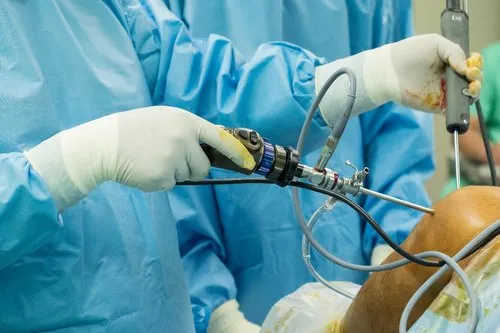Orthopaedic
Microscopic Marvels: Unveiling the Wonders of Arthroscopic Procedures

by admin
20th January 2024
5 minutes read
Introduction
In the world of modern medicine, the evolution of surgical techniques has given rise to microscopic marvels that are revolutionizing the field of orthopedics. Arthroscopic procedures, with their precision and minimal invasiveness, stand as a testament to medical innovation. This blog explores the fascinating universe of arthroscopy, delving into its applications, benefits, and the transformative wonders it works within the realm of joint care.
Understanding Arthroscopic Procedures
Arthroscopy, derived from the Greek words “arthro” (joint) and “skopein” (to look), involves the use of a slender instrument known as an arthroscope. This tiny, fiber-optic camera is inserted through small incisions to visualize and treat conditions within the joint. The magic lies in its ability to provide a close-up view of the joint without the need for extensive surgery.
The Marvels Unveiled
Precision on a Microscopic Scale:
- Arthroscopic procedures offer unparalleled precision. The miniature camera allows surgeons to navigate through joints with intricate detail, enabling precise diagnosis and targeted interventions. This precision minimizes collateral damage to surrounding tissues, promoting faster healing and reduced postoperative discomfort.
Minimally Invasive Miracles:
- Unlike traditional open surgeries, arthroscopy minimizes the trauma associated with larger incisions. Patients benefit from smaller, strategically placed cuts, resulting in less scarring, reduced blood loss, and a quicker return to their regular activities. The minimally invasive nature of arthroscopy marks a significant advancement in patient care.
Versatility Across Joints:
- Arthroscopy is not confined to a specific joint but spans a spectrum of orthopedic applications. From knees and shoulders to hips and ankles, this microscopic marvel adapts to various anatomical locations, offering solutions to a wide array of joint-related issues.
Applications of Arthroscopic Wonders
Knee Arthroscopy:
- Arthroscopic procedures in the knee are a cornerstone of orthopedic care. Surgeons can address issues such as torn ligaments, meniscus tears, and cartilage damage with precision, promoting optimal functionality and mobility.
Shoulder Arthroscopy:
- The shoulder, a complex joint prone to injuries, finds relief through arthroscopic miracles. From rotator cuff repairs to treating shoulder impingement, arthroscopy provides a less invasive avenue for addressing a range of shoulder-related concerns.
- Arthroscopy extends its reach to the hip joint, enabling surgeons to diagnose and treat conditions like labral tears and femoroacetabular impingement. This approach spares patients from extensive surgeries and facilitates faster recoveries.
Ankle Arthroscopy:
- Even the smaller joints, like the ankle, benefit from arthroscopic procedures. This microscopic marvel allows for the treatment of conditions such as cartilage damage and loose bodies, enhancing overall joint health.
Arthroscopic procedures have redefined the landscape of orthopedic surgery, offering a combination of precision, minimal invasiveness, and versatility. These procedures continue to evolve, shaping the future of joint care and providing patients with effective solutions for a wide range of joint-related issues.
The Transformative Impact on Patients
Faster Recovery, Quicker Return:
- The reduced trauma and minimal invasiveness associated with arthroscopic procedures contribute to faster recovery times. Patients experience less pain, and reduced swelling, and can often resume their daily activities sooner than with traditional open surgeries.
Cosmetically Appealing Outcomes:
- The smaller incisions made during arthroscopy result in less noticeable scars, providing patients with cosmetically appealing outcomes. This aspect not only addresses physical healing but also positively influences patients’ psychological well-being.
Advancements in Sports Medicine:
- Athletes, in particular, benefit from the wonders of arthroscopic procedures. The ability to precisely diagnose and treat sports-related injuries ensures a quicker return to peak performance, making arthroscopy a game-changer in the field of sports medicine.
Conclusion
In the world of orthopedics, arthroscopic procedures stand as microscopic marvels, transforming the way joint-related issues are diagnosed and treated. The precision, minimally invasive nature, and versatility of arthroscopy have ushered in a new era of patient-centric care. As technology continues to advance, these wonders are poised to unveil even greater possibilities, offering hope and healing to those seeking relief from joint ailments. The microscopic marvels of arthroscopic procedures are not just changing the way we look at surgery; they are shaping a future where precision and compassion converge to redefine the standard of care in orthopedics.
Also Read:
FAQs
Q. How long does a typical arthroscopic procedure take?
A. Arthroscopic procedures vary in duration depending on the complexity and the joint involved, but they generally range from 30 minutes to a few hours.
Q. What are the risks associated with arthroscopic surgery?
A. While considered safe, arthroscopic procedures carry minimal risks such as infection, bleeding, or nerve damage. Surgeons discuss potential complications with patients during the preoperative consultation.
Q. Is arthroscopy suitable for chronic joint conditions?
A. Arthroscopy is effective for various chronic joint conditions, providing targeted interventions for issues like arthritis, chronic inflammation, and degenerative joint diseases.
Q. Can arthroscopy be used as a diagnostic tool only?
A. Yes, arthroscopy serves not only as a treatment tool but also as a diagnostic aid. The real-time visualization allows surgeons to assess joint conditions accurately before deciding on the appropriate course of action.
CATEGORIES
- ACL Reconstruction
- Anal Fissures
- Anal Fistula
- Appendicitis
- ASK A DOCTOR
- Benign Prostatic Hyperplasia
- Breast Lump Excision
- Cataract
- Circumcision
- Conditions & Diseases
- Cosmetology
- Covid-19
- Cure
- Endocrinology
- ENGLISH VIDEOS
- Eye Care
- Gallstones
- General Surgeries
- Government Schemes
- Gynaecology
- Gynecomastia
- Gynecomastia
- Health
- Health Insurance
- Hernia
- hindi
- Hip Arthoscopy
- Hip Replacement
- Hip Replacement Surgery
- Hydrocele
- Kannada
- Kidney Stones
- Knee Arthroscopic
- Laparoscopic
- LASER
- Latest Treatments
- Lifestyle
- Liposuction
- Medfin Stories
- Medicine
- Nephrology
- Ophthalmology
- Orthopaedic
- Paraphimosis
- Patient Testimonials
- PCL Reconstruction
- Phimosis
- Piles (Hemorrhoids)
- Pilonidal Sinus
- Proctology
- Prostate Artery Embolization
- Rhinoplasty
- Second Opinion
- Total Knee Replacement
- Uncategorised
- Urology
- uterine artery embolization
- Uterine Fibroids
- Varicocele
- Varicose Veins
- Vascular
- VIDEOS






